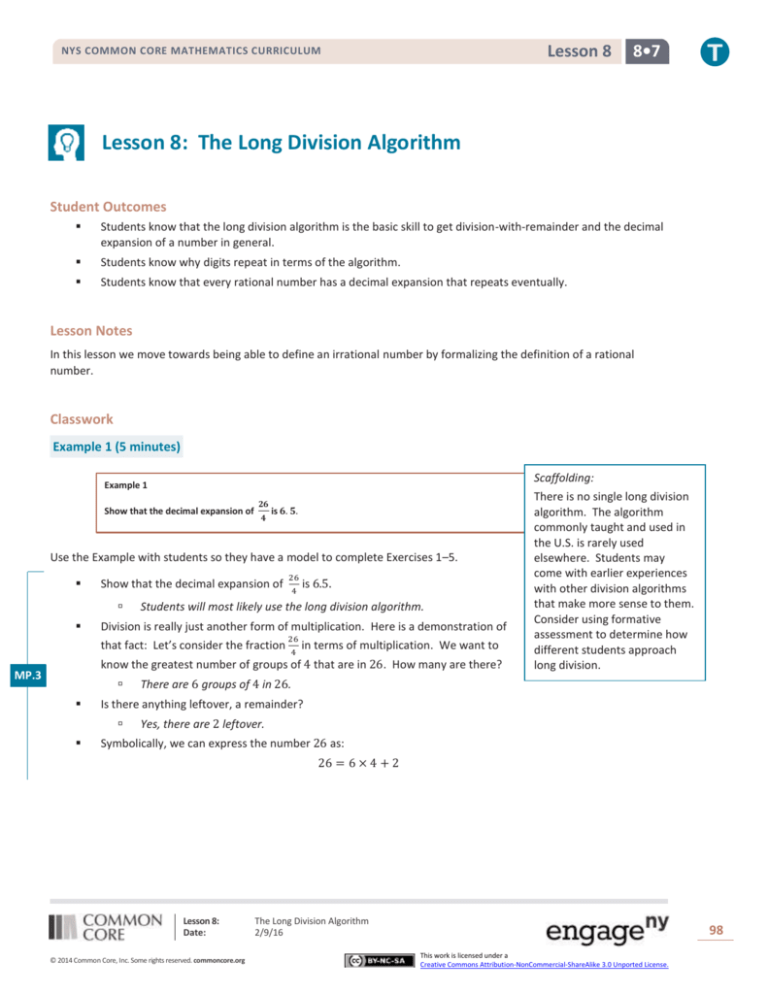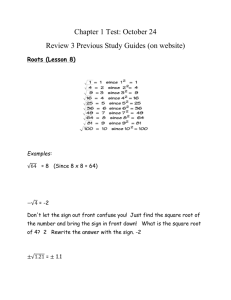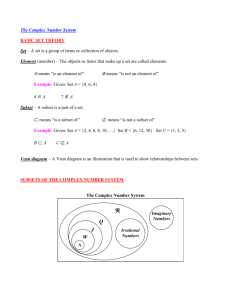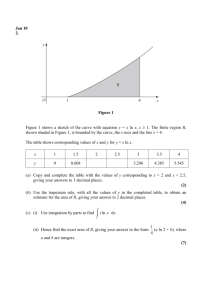
Lesson 8
NYS COMMON CORE MATHEMATICS CURRICULUM
8•7
Lesson 8: The Long Division Algorithm
Student Outcomes
Students know that the long division algorithm is the basic skill to get division-with-remainder and the decimal
expansion of a number in general.
Students know why digits repeat in terms of the algorithm.
Students know that every rational number has a decimal expansion that repeats eventually.
Lesson Notes
In this lesson we move towards being able to define an irrational number by formalizing the definition of a rational
number.
Classwork
Example 1 (5 minutes)
Scaffolding:
Example 1
Show that the decimal expansion of
𝟐𝟔
𝟒
is 𝟔. 𝟓.
Use the Example with students so they have a model to complete Exercises 1–5.
Show that the decimal expansion of
26
4
is 6.5.
Students will most likely use the long division algorithm.
Division is really just another form of multiplication. Here is a demonstration of
that fact: Let’s consider the fraction
26
4
in terms of multiplication. We want to
know the greatest number of groups of 4 that are in 26. How many are there?
MP.3
There are 6 groups of 4 in 26.
Is there anything leftover, a remainder?
There is no single long division
algorithm. The algorithm
commonly taught and used in
the U.S. is rarely used
elsewhere. Students may
come with earlier experiences
with other division algorithms
that make more sense to them.
Consider using formative
assessment to determine how
different students approach
long division.
Yes, there are 2 leftover.
Symbolically, we can express the number 26 as:
26 = 6 × 4 + 2
Lesson 8:
Date:
© 2014 Common Core, Inc. Some rights reserved. commoncore.org
The Long Division Algorithm
2/9/16
98
This work is licensed under a
Creative Commons Attribution-NonCommercial-ShareAlike 3.0 Unported License.
Lesson 8
NYS COMMON CORE MATHEMATICS CURRICULUM
With respect to the fraction
The fraction
MP.3
26
4
26
4
8•7
we can represent the division as
26 6 × 4 + 2
=
4
4
26 6 × 4 2
=
+
4
4
4
26
2
=6+
4
4
26
2
1
=6 =6
4
4
2
is equal to the finite decimal 6.5. When the fraction is not equal to a finite decimal, then we
need to use the long division algorithm to determine the decimal expansion of the number.
Exploratory Challenge
Exercises 1–5 (15 minutes)
Students complete Exercises 1–5 independently or in pairs. The discussion that follows is related to the concepts in the
Exercises.
Exercises 1–5
1.
Use long division to determine the decimal expansion of
𝟏𝟒𝟐
𝟐
.
71.0
2 142.0
a.
Fill in the blanks to show another way to determine the decimal expansion of
𝟏𝟒𝟐 =
𝟕𝟏
×𝟐+
𝟏𝟒𝟐
𝟐
.
𝟎
𝟏𝟒𝟐
𝟕𝟏 × 𝟐 + 𝟎
=
𝟐
𝟐
𝟏𝟒𝟐
𝟕𝟏 × 𝟐
𝟎
=
+
𝟐
𝟐
𝟐
𝟏𝟒𝟐
𝟎
= 𝟕𝟏 +
𝟐
𝟐
𝟏𝟒𝟐
=
𝟕𝟏. 𝟎
𝟐
b.
Does the number
𝟏𝟒𝟐
𝟐
have a finite or infinite decimal expansion? Explain how you know.
The decimal expansion of
𝟏𝟒𝟐
𝟐
is 𝟕𝟏. 𝟎 and is finite because the denominator of the fraction, 𝟐, can be
expressed as a product of 𝟐’s.
2.
Use long division to determine the decimal expansion of
𝟏𝟒𝟐
𝟒
.
35.5
4 142.0
Lesson 8:
Date:
© 2014 Common Core, Inc. Some rights reserved. commoncore.org
The Long Division Algorithm
2/9/16
99
This work is licensed under a
Creative Commons Attribution-NonCommercial-ShareAlike 3.0 Unported License.
Lesson 8
NYS COMMON CORE MATHEMATICS CURRICULUM
a.
Fill in the blanks to show another way to determine the decimal expansion of
𝟏𝟒𝟐 =
𝟑𝟓
×𝟒+
𝟏𝟒𝟐
𝟑𝟓
=
𝟒
b.
Does the number
𝟏𝟒𝟐
𝟒
.
×𝟒+ 𝟐
𝟒
𝟏𝟒𝟐
= 𝟑𝟓
𝟒
𝟑𝟓
𝟒
𝟐
𝟏𝟒𝟐
𝟑𝟓
×𝟒
=
+
𝟒
𝟒
𝟏𝟒𝟐
=
𝟒
𝟏𝟒𝟐
8•7
𝟐
𝟒
𝟐
𝟒
+
𝟐
= 𝟑𝟓. 𝟓
𝟒
have a finite or infinite decimal expansion? Explain how you know.
The decimal expansion of
𝟏𝟒𝟐
𝟒
is 𝟑𝟓. 𝟓 and is finite because the denominator of the fraction, 𝟒, can be
expressed as a product of 𝟐’s.
3.
Use long division to determine the decimal expansion of
𝟏𝟒𝟐
𝟔
.
23.666
6 142.000
12
22
18
40
36
40
36
40
36
4
a.
Fill in the blanks to show another way to determine the decimal expansion of
𝟏𝟒𝟐 =
𝟐𝟑
×𝟔+
𝟏𝟒𝟐
𝟔
.
𝟒
𝟏𝟒𝟐
𝟐𝟑
×𝟔+ 𝟒
=
𝟔
𝟔
𝟏𝟒𝟐
𝟐𝟑
×𝟔
𝟒
=
+
𝟔
𝟔
𝟔
𝟏𝟒𝟐
𝟒
= 𝟐𝟑 +
𝟔
𝟔
𝟏𝟒𝟐
𝟒
= 𝟐𝟑 = 𝟐𝟑. 𝟔𝟔𝟔 …
𝟔
𝟔
b.
Does the number
𝟏𝟒𝟐
𝟔
have a finite or infinite decimal expansion? Explain how you know.
The decimal expansion of
𝟏𝟒𝟐
𝟔
is 𝟐𝟑. 𝟔𝟔𝟔 … and is infinite because the denominator of the fraction, 𝟔, cannot
be expressed as a product of 𝟐’s and/or 𝟓’s.
Lesson 8:
Date:
© 2014 Common Core, Inc. Some rights reserved. commoncore.org
The Long Division Algorithm
2/9/16
100
This work is licensed under a
Creative Commons Attribution-NonCommercial-ShareAlike 3.0 Unported License.
Lesson 8
NYS COMMON CORE MATHEMATICS CURRICULUM
4.
Use long division to determine the decimal expansion of
𝟏𝟒𝟐
𝟏𝟏
8•7
.
12.90909
11 142.00000
11
32
22
100
99
10
00
100
99
10
00
100
99
10
a.
Fill in the blanks to show another way to determine the decimal expansion of
𝟏𝟒𝟐 =
𝟏𝟐
× 𝟏𝟏 + 𝟏𝟎
𝟏𝟒𝟐
=
𝟏𝟏
𝟏𝟐
× 𝟏𝟏 + 𝟏𝟎
𝟏𝟏
𝟏𝟒𝟐
𝟏𝟏
.
𝟏𝟒𝟐
𝟏𝟐
× 𝟏𝟏
𝟏𝟎
=
+
𝟏𝟏
𝟏𝟏
𝟏𝟏
𝟏𝟒𝟐
𝟏𝟎
= 𝟏𝟐 +
𝟏𝟏
𝟏𝟏
𝟏𝟒𝟐
𝟏𝟎
= 𝟏𝟐
= 𝟏𝟐. 𝟗𝟎𝟗𝟎𝟗 …
𝟏𝟏
𝟏𝟏
b.
Does the number
𝟏𝟒𝟐
𝟏𝟏
have a finite or infinite decimal expansion? Explain how you know.
The decimal expansion of
𝟏𝟒𝟐
𝟏𝟏
is 𝟏𝟐. 𝟗𝟎𝟗𝟎𝟗 … and is infinite because the denominator of the fraction, 𝟔,
cannot be expressed as a product of 𝟐’s and/or 𝟓’s.
5.
Which fractions produced an infinite decimal expansion? Why do you think that is?
The fractions that required the long division algorithm to determine the decimal expansion were
𝟏𝟒𝟐
𝟔
and
𝟏𝟒𝟐
𝟏𝟏
. The
fact that these numbers had an infinite decimal expansion is due to the fact that the divisor was not a product of 𝟐’s
and/or 𝟓’s compared to the first two fractions where the divisor was a product of 𝟐’s and/or 𝟓’s. In general, the
decimal expansion of a number will be finite when the divisor, i.e., the denominator of the fraction, can be expressed
as a product of 𝟐’s and/or 𝟓’s. Similarly, the decimal expansion will be infinite when the divisor cannot be expressed
as a product of 𝟐’s and/or 𝟓’s.
Lesson 8:
Date:
© 2014 Common Core, Inc. Some rights reserved. commoncore.org
The Long Division Algorithm
2/9/16
101
This work is licensed under a
Creative Commons Attribution-NonCommercial-ShareAlike 3.0 Unported License.
Lesson 8
NYS COMMON CORE MATHEMATICS CURRICULUM
8•7
Discussion (10 minutes)
What is the decimal expansion of
142
2
?
If students respond “71”, ask them what decimal digits they could include without changing the value of the number.
is equal to the decimal 71.00000 …
No, the long division algorithm was not necessary because there was a whole number of 2’s in 142.
The fraction
142
4
142
4
?
is equal to the decimal 35.5.
What decimal digits could we include to the right of the 0.5 without changing the value?
2
What is the decimal expansion of
142
Did you need to use the long division algorithm to determine your answer? Why or why not?
The fraction
We could write the decimal as 35.500000 …
Did you need to use the long division algorithm to determine your answer? Why or why not?
No, the long division algorithm was not necessary because
2
142
4
2
2
4
4
= 35 + and is a finite decimal. We
could use what we learned in the last lesson to write as 0.5.
4
What is the decimal expansion of
The fraction
142
6
142
6
?
is equal to the decimal 23.66666 …
Did you need to use the long division algorithm to determine your answer? Why or why not?
Yes, the long division algorithm was necessary because
142
6
2
2
2
3
3
= 23 + and is not a finite decimal.
Note: Some students may have recognized the fraction as 0.6666 … and not used the long division
3
algorithm to determine the decimal expansion.
How did you know when you could stop dividing?
I knew to stop dividing because the remainder kept repeating. Specifically, when I used the long
division algorithm, the number 40 kept appearing, and there are 6 groups of 6 in 40, leaving 4 as a
remainder each time, which became 40 when I brought down another 0.
We represent the decimal expansion of
142
6
as 23. 6̅, where the line above the 6 is the “repeating block”; that
is, the digit 6 repeats as we saw in the long division algorithm.
What is the decimal expansion of
11
11
?
is equal to the decimal 12.90909090 …
Did you need to use the long division algorithm to determine your answer? Why or why not?
The fraction
142
142
Yes, the long division algorithm was necessary because
142
11
= 12 +
10
11
and
10
11
is not a finite decimal.
How did you know when you could stop dividing?
I knew to stop dividing because the remainder kept repeating. Specifically, when I used the long
division algorithm, I kept getting the number 10, which is not divisible by 11, so I had to bring down
another 0 making the number 100. This kept happening, so I knew to stop once I noticed the work I
was doing was the same.
Lesson 8:
Date:
© 2014 Common Core, Inc. Some rights reserved. commoncore.org
The Long Division Algorithm
2/9/16
102
This work is licensed under a
Creative Commons Attribution-NonCommercial-ShareAlike 3.0 Unported License.
Lesson 8
NYS COMMON CORE MATHEMATICS CURRICULUM
Which block of digits kept repeating?
The block of digits that kept repeating was 90.
How do we represent the decimal expansion of
8•7
The decimal expansion of
142
11
142
11
?
̅̅̅̅.
is 12. 90
In general, we say that every rational number has a decimal expansion that repeats eventually. It is obvious by
the repeat blocks that
142
6
and
142
11
are rational numbers. Are the numbers
142
2
and
142
4
rational? If so, what is
their repeat block?
Provide students a minute or two to discuss in small groups what the repeat blocks for
The decimal expansion of
142
2
142
2
and
142
4
are.
is 71.0000 … where the repeat block is 0. The decimal expansion of
35.50000 … where the repeat block is 0. Since the numbers
142
2
and
142
4
142
4
is
have decimal expansions that
repeat, then the numbers are rational.
Exercises 6–10 (5 minutes)
Students complete Exercises 6–10 independently.
Exercises 6–10
6.
Does the number
𝟔𝟓
𝟏𝟑
have a finite or infinite decimal expansion? Based on our definition of rational numbers having
a decimal expansion that repeats eventually, is the number rational? Explain.
The number
𝟔𝟓
𝟏𝟑
=
𝟓×𝟏𝟑
𝟏𝟑
= 𝟓 so it is a finite decimal. The decimal expansion of
𝟔𝟓
𝟏𝟑
is 𝟓. 𝟎𝟎𝟎𝟎 … where the repeat
block is 𝟎. Therefore, the number is rational.
7.
Does the number
𝟏𝟕
𝟏𝟏
have a finite or infinite decimal expansion? Based on our definition of rational numbers having
a decimal expansion that repeats eventually, is the number rational? Explain.
𝟏𝟕 𝟏 × 𝟏𝟏 𝟔
=
+
𝟏𝟏
𝟏𝟏
𝟏𝟏
1.5454
11 17.00000
11
60
55
50
44
60
55
50
44
60
The number
𝟏𝟕
𝟏𝟏
has an infinite decimal expansion, 𝟏. ̅̅̅̅
𝟓𝟒. The block of digits 𝟓𝟒 repeats. In doing the long division, I
realized that the remainder of 𝟔 and remainder of 𝟓 kept reappearing in my work. Since the number has a repeat
block, it is rational.
Lesson 8:
Date:
© 2014 Common Core, Inc. Some rights reserved. commoncore.org
The Long Division Algorithm
2/9/16
103
This work is licensed under a
Creative Commons Attribution-NonCommercial-ShareAlike 3.0 Unported License.
Lesson 8
NYS COMMON CORE MATHEMATICS CURRICULUM
8.
8•7
Does the number 𝝅 = 𝟑. 𝟏𝟒𝟏𝟓𝟗𝟐𝟔𝟓𝟑𝟓𝟖𝟗𝟕 … have a finite or infinite decimal expansion? Based on our definition of
rational numbers having a decimal expansion that repeats eventually, is the number rational? Explain.
The number has an infinite decimal expansion. However, it does not have decimal digits that repeat in a block. For
that reason, the number is not rational.
9.
Does the number
𝟖𝟔𝟎
𝟗𝟗𝟗
= 𝟎. 𝟖𝟔𝟎𝟖𝟔𝟎𝟖𝟔𝟎 … have a finite or infinite decimal expansion? Based on our definition of
rational numbers having a decimal expansion that repeats eventually, is the number rational? Explain.
The number has an infinite decimal expansion. However, the decimal expansion has a repeat block of 𝟖𝟔𝟎. Because
every rational number has a block that repeats, the number is rational.
10. Does the number √𝟐 = 𝟏. 𝟒𝟏𝟒𝟐𝟏𝟑𝟓𝟔𝟐𝟑𝟕 … have a finite or infinite decimal expansion? Based on our definition of
rational numbers having a decimal expansion that repeats eventually, is the number rational? Explain.
The number has an infinite decimal expansion. However, it does not have decimal digits that repeat in a block. For
that reason, the number is not rational.
Closing (5 minutes)
Summarize, or ask students to summarize, the main points from the lesson:
We know that the long division algorithm is a procedure that allows us to write the decimal expansion for
infinite decimals.
We know that every rational number has a decimal expansion that repeats eventually.
Lesson Summary
The long division algorithm is a procedure that can be used to determine the decimal expansion of infinite decimals.
Every rational number has a decimal expansion that repeats eventually. For example, the number 𝟑𝟐 is rational
𝟏
̅. The number is rational because it has a
because it has a repeat block of the digit 𝟎 in its decimal expansion, 𝟑𝟐. 𝟎
𝟑
̅. The number 𝟎. 𝟒𝟓𝟒𝟓𝟒𝟓 … is rational because it has a
repeat block of the digit 𝟑 in its decimal expansion, 𝟎. 𝟑
repeat block of the digits 𝟒𝟓 in its decimal expansion, 𝟎. ̅̅̅̅
𝟒𝟓.
Exit Ticket (5 minutes)
Lesson 8:
Date:
© 2014 Common Core, Inc. Some rights reserved. commoncore.org
The Long Division Algorithm
2/9/16
104
This work is licensed under a
Creative Commons Attribution-NonCommercial-ShareAlike 3.0 Unported License.
Lesson 8
NYS COMMON CORE MATHEMATICS CURRICULUM
Name
8•7
Date
Lesson 8: The Long Division Algorithm
Exit Ticket
1.
Write the decimal expansion of
125
8
. Based on our definition of rational numbers having a decimal expansion that
repeats eventually, is the number rational? Explain.
2.
Write the decimal expansion of
13
7
. Based on our definition of rational numbers having a decimal expansion that
repeats eventually, is the number rational? Explain.
Lesson 8:
Date:
© 2014 Common Core, Inc. Some rights reserved. commoncore.org
The Long Division Algorithm
2/9/16
105
This work is licensed under a
Creative Commons Attribution-NonCommercial-ShareAlike 3.0 Unported License.
Lesson 8
NYS COMMON CORE MATHEMATICS CURRICULUM
8•7
Exit Ticket Sample Solutions
1.
Write the decimal expansion of
𝟏𝟐𝟓
𝟖
. Based on our definition of rational numbers having a decimal expansion that
repeats eventually, is the number rational? Explain.
𝟏𝟐𝟓 𝟏𝟓 × 𝟖 𝟓
=
+
𝟖
𝟖
𝟖
𝟓
= 𝟏𝟓
𝟖
15.625
8 125.000
0
12
8
45
40
50
48
20
16
40
40
0
The decimal expansion of
𝟏𝟐𝟓
𝟖
is 𝟏𝟓. 𝟔𝟐𝟓. The number is rational because it is a finite decimal with a repeating
block of 𝟎.
2.
Write the decimal expansion of
𝟏𝟑
𝟕
. Based on our definition of rational numbers having a decimal expansion that
repeats eventually, is the number rational? Explain.
𝟏𝟑 𝟏 × 𝟕 𝟔
=
+
𝟕
𝟕
𝟕
𝟔
=𝟏
𝟕
1.857142857142
7 13.0000000000000
7
60
56
40
35
50
49
10
7
30
28
20
14
60
56
40
35
50
The decimal expansion of
𝟏𝟑
𝟕
̅̅̅̅̅̅̅̅̅̅̅. The number is rational because there is a repeating block of 𝟖𝟓𝟕𝟏𝟒𝟐.
is 𝟏. 𝟖𝟓𝟕𝟏𝟒𝟐
Rational numbers have decimal expansions that repeat; therefore,
Lesson 8:
Date:
© 2014 Common Core, Inc. Some rights reserved. commoncore.org
𝟏𝟑
𝟕
is a rational number.
The Long Division Algorithm
2/9/16
106
This work is licensed under a
Creative Commons Attribution-NonCommercial-ShareAlike 3.0 Unported License.
Lesson 8
NYS COMMON CORE MATHEMATICS CURRICULUM
8•7
Problem Set Sample Solutions
1.
Write the decimal expansion of
𝟕𝟎𝟎𝟎
𝟗
. Based on our definition of rational numbers having a decimal expansion that
repeats eventually, is the number rational? Explain.
𝟕𝟎𝟎𝟎 𝟕𝟕𝟕 × 𝟗 𝟕
=
+
𝟗
𝟗
𝟗
𝟕
= 𝟕𝟕𝟕
𝟗
777.77
9 7000.00
63
70
63
70
63
70
63
70
63
70
The decimal expansion of
𝟕𝟎𝟎𝟎
𝟗
̅. The number is rational because it has the repeating digit of 𝟕. Rational
is 𝟕𝟕𝟕. 𝟕
numbers have decimal expansions that repeat; therefore,
2.
Write the decimal expansion of
𝟕𝟎𝟎𝟎
𝟗
is a rational number.
𝟔𝟓𝟓𝟓𝟓𝟓𝟓
𝟑
. Based on our definition of rational numbers having a decimal expansion
that repeats eventually, is the number rational? Explain.
𝟔𝟓𝟓𝟓𝟓𝟓𝟓 𝟐𝟏𝟖𝟓𝟏𝟖𝟓 × 𝟑 𝟎
=
+
𝟑
𝟑
𝟑
= 𝟐, 𝟏𝟖𝟓, 𝟏𝟖𝟓
The decimal expansion of
𝟔𝟓𝟓𝟓𝟓𝟓𝟓
𝟑
is 𝟐, 𝟏𝟖𝟓, 𝟏𝟖𝟓. The number is rational because we can write the repeating digit
of 𝟎 following the whole number. Rational numbers have decimal expansions that repeat; therefore,
𝟔𝟓𝟓𝟓𝟓𝟓𝟓
𝟑
is a
rational number.
Lesson 8:
Date:
© 2014 Common Core, Inc. Some rights reserved. commoncore.org
The Long Division Algorithm
2/9/16
107
This work is licensed under a
Creative Commons Attribution-NonCommercial-ShareAlike 3.0 Unported License.
Lesson 8
NYS COMMON CORE MATHEMATICS CURRICULUM
3.
Write the decimal expansion of
8•7
𝟑𝟓𝟎𝟎𝟎𝟎
. Based on our definition of rational numbers having a decimal expansion
𝟏𝟏
that repeats eventually, is the number rational? Explain.
31818.18
11 350, 000.00
𝟑𝟓𝟎𝟎𝟎𝟎 𝟑𝟏, 𝟖𝟏𝟖 × 𝟏𝟏 𝟐
=
+
𝟏𝟏
𝟏𝟏
𝟏𝟏
𝟐
= 𝟑𝟏, 𝟖𝟏𝟖
𝟏𝟏
33
20
11
90
88
20
11
90
88
20
11
90
88
20
The decimal expansion of
𝟑𝟓𝟎𝟎𝟎𝟎
𝟏𝟏
̅̅̅̅. The number is rational because there is a repeating block of 𝟏𝟖.
is 𝟑𝟏𝟖𝟏𝟖. 𝟏𝟖
Rational numbers have decimal expansions that repeat; therefore,
4.
Write the decimal expansion of
𝟑𝟓𝟎𝟎𝟎𝟎
𝟏𝟏
is a rational number.
𝟏𝟐𝟎𝟎𝟎𝟎𝟎𝟎
𝟑𝟕
. Based on our definition of rational numbers having a decimal expansion
that repeats eventually, is the number rational? Explain.
𝟏𝟐, 𝟎𝟎𝟎, 𝟎𝟎𝟎 𝟑𝟐𝟒, 𝟑𝟐𝟒 × 𝟑𝟕 𝟏𝟐
=
+
𝟑𝟕
𝟑𝟕
𝟑𝟕
𝟏𝟐
= 𝟑𝟐𝟒, 𝟑𝟐𝟒
𝟑𝟕
324324.324
37 12,000,000.000
111
90
74
160
148
120
111
90
74
160
148
120
111
90
74
160
148
120
The decimal expansion of
𝟏𝟐𝟎𝟎𝟎𝟎𝟎𝟎
𝟑𝟕
̅̅̅̅̅̅. The number is rational because there is a repeating block of
is 𝟑𝟐𝟒, 𝟑𝟐𝟒. 𝟑𝟐𝟒
𝟑𝟐𝟒. Rational numbers have decimal expansions that repeat; therefore,
Lesson 8:
Date:
© 2014 Common Core, Inc. Some rights reserved. commoncore.org
𝟏𝟐𝟎𝟎𝟎𝟎𝟎𝟎
𝟑𝟕
is a rational number.
The Long Division Algorithm
2/9/16
108
This work is licensed under a
Creative Commons Attribution-NonCommercial-ShareAlike 3.0 Unported License.
Lesson 8
NYS COMMON CORE MATHEMATICS CURRICULUM
5.
8•7
Someone notices that the long division of 𝟐, 𝟐𝟐𝟐, 𝟐𝟐𝟐 by 𝟔 has a quotient of 𝟑𝟕𝟎, 𝟑𝟕𝟎 and remainder 𝟐 and
wonders why there is a repeating block of digits in the quotient, namely 𝟑𝟕𝟎. Explain to the person why this
happens.
𝟐𝟐𝟐𝟐𝟐𝟐𝟐 𝟑𝟕𝟎, 𝟑𝟕𝟎 × 𝟔 𝟐
=
+
𝟔
𝟔
𝟔
𝟐
= 𝟑𝟕𝟎, 𝟑𝟕𝟎
𝟔
370370
6 2222222
18
42
42
022
18
42
42
02
The reason that the block of digits 𝟑𝟕𝟎 keeps repeating is because the long division algorithm leads us to perform
the same division over and over again. In the algorithm shown above, we see that there 𝟑 groups of 𝟔 in 𝟐𝟐, leaving
a remainder of 𝟒. When we bring down the next 𝟐 we see that there are exactly 𝟕 groups of 𝟔 in 𝟒𝟐. When we
bring down the next 𝟐 we see that there are 𝟎 groups of 𝟔 in 𝟐, leaving a remainder of 𝟐. It is then that the process
starts over because the next step is to bring down another 𝟐, giving us 𝟐𝟐, which is what we started with. Since the
division repeats, then the digits in the quotient will repeat.
6.
Is the number
𝟗
𝟏𝟏
= 𝟎. 𝟖𝟏𝟖𝟏𝟖𝟏𝟖𝟏 … rational? Explain.
The number appears to be rational because the decimal expansion has a repeat block of 𝟖𝟏. Because every rational
number has a block that repeats, the number is rational.
7.
Is the number √𝟑 = 𝟏. 𝟕𝟑𝟐𝟎𝟓𝟎𝟖𝟎 … rational? Explain.
The number appears to have a decimal expansion that does not have decimal digits that repeat in a block. For that
reason, this is not a rational number.
8.
Is the number
𝟒𝟏
𝟑𝟑𝟑
= 𝟎. 𝟏𝟐𝟑𝟏𝟐𝟑𝟏𝟐𝟑𝟏 … rational? Explain.
The number appears to be rational because the decimal expansion has a repeat block of 𝟏𝟐𝟑. Because every
rational number has a block that repeats, the number is rational.
Lesson 8:
Date:
© 2014 Common Core, Inc. Some rights reserved. commoncore.org
The Long Division Algorithm
2/9/16
109
This work is licensed under a
Creative Commons Attribution-NonCommercial-ShareAlike 3.0 Unported License.








